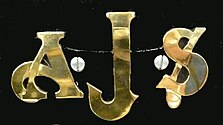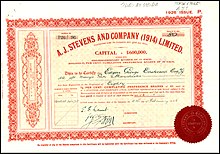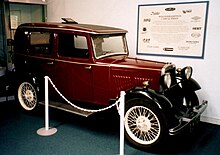AJS
| AJ Stevens & Co.
|
|
|---|---|
| legal form | Ltd. |
| founding | 1909 |
| Seat | Wolverhampton , England, UK |
| Branch | Motorcycle manufacturer , automobile manufacturer |
| Website | www.ajsmotorcycles.co.uk |
AJS ( AJ Stevens & Co Ltd. ), named after Albert John Stevens , is one of the most famous English manufacturers in motorcycle history . The company was based in Wolverhampton from 1909 to 1931 . The brand continues to exist under different owners with interruptions.
history
prehistory
Albert John Stevens built his first gasoline-powered engine in his parents' blacksmith business as early as 1897 . One of its main customers was Wearwell Motor Carriage Company Ltd , also based in Wolverhampton.
AJ Stevens & Co. Ltd
Over the years, the realization matured that more money could be made by building motorcycles. So Albert John Stevens in 1909 founded with his brothers Harry , George and Joe the AJ Stevens & Co. Ltd . All four brothers were good motorcyclists and had a number of successes on long distance rides. The first light motorcycles from our own production were presented, which were equipped with single-cylinder engines and two-speed transmissions. This first AJS had an engine with 292 cm³ displacement (bore × stroke = 70 mm × 76 mm). In the following year there was already a motorcycle with a V- 2 engine, 800 cm³ displacement and a three-speed gearbox.
In 1914 the stock corporation AJ Stevens & Company (1914) Limited was founded due to high demand to finance a company expansion . At the Tourist Trophy on the Isle of Man , Eric Williams won the junior race with a 350 AJS as the first single-cylinder motorcycle. AJS became a well-known brand and a new factory on Penn Road in Wolverhampton was opened to handle the many orders.
After the First World War , in 1921 Williams was able to repeat victory in the Junior TT and also win the Senior TT (500 cc class). The heavily revised machine reached a top speed of 120 km / h. In addition, places two, three, four, six and eight were occupied by AJS drivers. In 1926 a single-cylinder AJS with a displacement of 500 cc drove a TT lap for the first time at an average speed of 70 mph (112 km / h).
In the 1920s, AJS built motorcycles with displacements from 250 to 800 cm³; In addition to the single cylinders, there were longitudinally and transversely installed V2 engines and even a longitudinally installed four-cylinder in - line engine . In 1927 there was the first 350 cm³ single-cylinder engine with an overhead camshaft . In 1929 the entire model range was converted to OHV valve control and the large V2 engine got a displacement of 996 cm³. In the 1930s, AJS became the second largest British motorcycle manufacturer.
AJS has been manufacturing delivery vans since 1927. At around the same time, the production of radio sets began. Automobiles were also offered between 1930 and 1933 . The 9 HP model had a four-cylinder engine with a capacity of 1018 cm³ and delivered 24 bhp (17.6 kW). There was the body forms four-door sedan , two-door torpedo and just such Roadster . Two vehicles of this brand can be seen at the Black Country Living Museum in Dudley .
As a result of this fragmentation of its activities, AJS ran into financial difficulties in 1931. Harry and Charlie Collier bought the company. The entire production plant was brought to Plumstead in order to build the AJS motorcycles together with Matchless machines. The name AJS remained as a brand. The Stevens Brothers founded a new company in Wolverhampton under the name Stevens Brothers (Wolverhampton) Ltd. Automobile production was taken over by Willys-Overland- Crossley, but stopped in 1932.
AJS under Associated Motor Cycles and Norton-Villiers
In 1938 the Collier brothers combined their two brands Matchless , Sunbeam and AJS under the umbrella of a new company, the Associated Motor Cycles .
In the same year the AJS V-four was presented. The machine had a transversely installed V4 engine with a displacement of 500 cm³ and a sprung rear wheel. The racing machine constantly had problems with the cooling of the rear cylinders, which even the installation of a water cooling system could not solve. The water-cooled version also had a compressor . The AJS "Porcupine" (English: porcupine, so called because of the ribbed, almost lying and parallel cylinders) also had a compressor. The 500 cc two-cylinder model was created during World War II . After the war, supercharged motors were banned from racing and so Jock West was able to achieve some racing successes with the 40 bhp (29 kW) machine without a compressor, but the model was not really competitive.
Also in 1938, a new 350 cc single-cylinder model called the R7 appeared with an upright single-cylinder engine, overhead camshaft and hairpin valve springs. After the Second World War, the revised machine presented in 1949 was called the AJS 7R “Boy-Racer”. The machine dominated the junior TT in the 1950s and proved to be one of the most successful racing machines in the world until production was discontinued in 1961.
In 1965 the factory stopped the last racing activities. In 1966, Matchless, AJS and the Norton brand, which had since been added, merged into a new company of the Manganese-Bronze group, Norton-Villiers . In 1968 the plant was finally shut down.
AJS self-employed again
In 1974 the former NVT engineer Fluff Brown acquired the naming rights to AJS and continued to produce the AJS motocross motorcycles "Stormer" with 250 cc and 350 cc two-stroke engines in Andover .
Since opening a plant in the People's Republic of China , he has been producing the AJS CR3, a 125 cm³ street motorcycle, as well as the soft choppers of the Regal Raptor series.
Some models
- AJS 7R "Boy Racer": 348 cm³ single cylinder with approx. 45 hp
- AJS E95 "Porcupine": 498 cm³ DOHC parallel twin with 55 hp at 7600 rpm
- AJS 31
- AJS 35/2 1000 cc
- AJS Double-T Racer: 247 cm³ single-cylinder two-stroke engine with approx. 32 hp
Motorcycle racing
Motorcycle world championship
Overall, AJS was able to win a driver and a constructor world championship in the motorcycle world championship .
![]() Leslie Graham (1)
Leslie Graham (1)
- World champion in the 500 cm³ class: 1949
European motorcycle championship
The manufacturer won five drivers' titles in the European motorcycle championship .
![]() Jimmie Simpson (3)
Jimmie Simpson (3)
![]() Frank Longman (1)
Frank Longman (1)
- European champion in the 350 cm³ class: 1926
![]() Leo Davenport (1)
Leo Davenport (1)
- European champion in the 350 cm³ class: 1929
Isle of Man TT victories
| year | class | driver |
|---|---|---|
| 1914 | Junior |
|
| 1920 | Junior |
|
| 1921 | Junior |
|
| 1921 | Senior |
|
| 1922 | Junior |
|
| 1930 | Lightweight |
|
| 1931 | Lightweight |
|
| 1947 | Clubmans Lightweight |
|
| 1954 | Junior |
|
| 1959 | 350 cc formula 1 |
|
literature
- Ian Ward, Laurie Caddell (Editor): Great British Bikes . Orbis Publishing, London 1984. ISBN 0-85613-605-0 . AJS . Pp. 9-16. (English)
- Harald H. Linz, Halwart Schrader : The International Automobile Encyclopedia . United Soft Media Verlag, Munich 2008, ISBN 978-3-8032-9876-8 .
- George Nick Georgano (Editor-in-Chief): The Beaulieu Encyclopedia of the Automobile. Volume 1: A – F. Fitzroy Dearborn Publishers, Chicago 2001, ISBN 1-57958-293-1 . (English)
Web links
- AJS Motorcycles Ltd. (English)
- Wolverhampton AJS history ( Memento from October 1, 2012 in the Internet Archive )
- Regal Raptor (Germany + Austria)
- Vintage Motorcycles - AJS Motorcycles
Individual evidence
- ↑ http://www.historywebsite.co.uk/Museum/Transport/Motorcycles/ajs4.htm
- ^ Helmut Krackowizer: Motorcycles. Verlag Welsermühl, Munich 1981, ISBN 3-85339-170-2 , p. 17.





